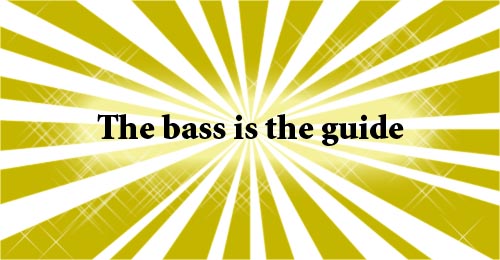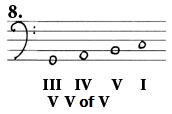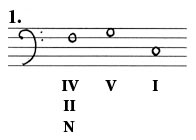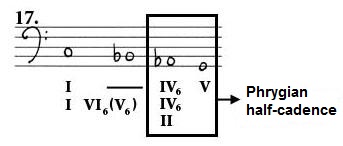3. USER'S GUIDE TO THE LITTLE CATALOGUE AND VARIOUS INSTRUCTIONS
In
response to our original quest for tools with which to identify auditory and
visual markers, this prefabricated material is all the more easily
recognizable because it includes characteristic melodic motifs which
reside, most of the time, in the bass. Already, a tool
for listening and reading takes shape and may be articulated as
follows:

THE BASS, THE BASS, THE BASS, AND ALWAYS THE BASS.
Once
a melodic motif has been recognized in the bass line, we have only to
consult the little catalogue in order to infer a harmonic response, or
several in some cases, and then to verify it or them. However, before
proceding to a systematic examination of these motifs throughout diverse fragments from the
repertoire, we must note that:
-
the different harmonic formulations associated with each characteristic
melodic motif are valid only as long as each melodic movement
corresponds to a harmonic movement (otherwise, for
example, motif no 8 involving the degrees 5-6-7-1 could be
harmonized with only V - I)
for example:

could be reduced to V - I
|
- any substitute for I (such as VI, IV, or V of...) may appear at the end of these formulas
for example:

could be stated: IV-V-VI |
- all the formulas can end with V (half cadence)
for example:

the function I may be omitted
|
- formulas ending with V may be extended to I
for example:

could continue to include a resolution to the tonic |
- motifs nos 9 and 10 have been notated in the treble clef rather than
in the bass clef because they are most often heard in an upper voice
-
these formulas may appear in varied form with respect to the
disposition of voices and even the quality of the chords used, on the
condition that the characteristic melodic motif remains recognizable
- these formulas may be combined, overlapped, reduced, augmented...

Having
made these clarifications, let us procede to illustrating the
diverse formulas from the little catalogue by drawing on the immense
reservoir of works in the corpus Bach-Wagner, sometimes gleaning above
and beyond on the condition that a reference to the same tonal
language is undeniably apparent, and by using a larger number of
examples for the figures that appear with most persistance throughout
the repertoire.
5. EXAMPLES ILLUSTRATING THE LITTLE CATALOGUE
